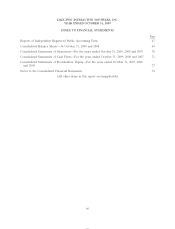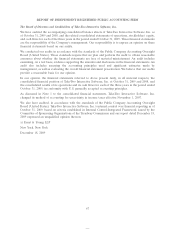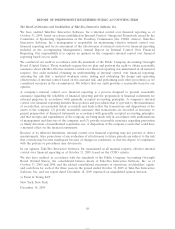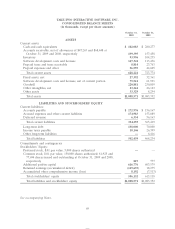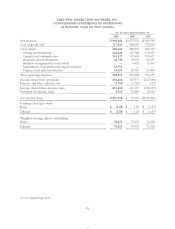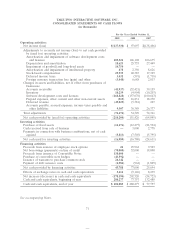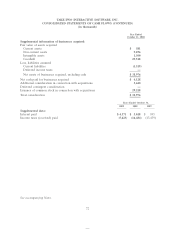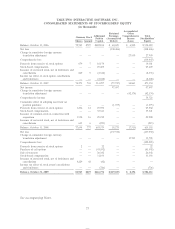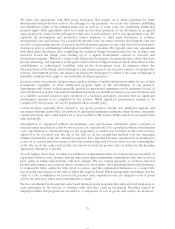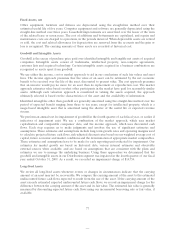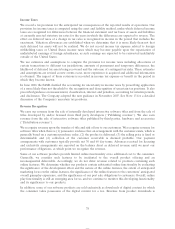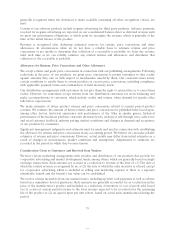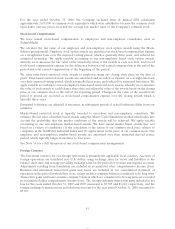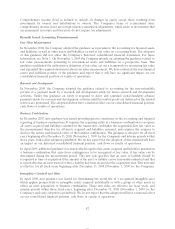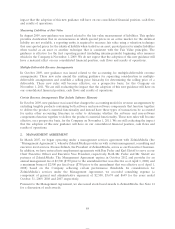2K Sports 2009 Annual Report Download - page 81
Download and view the complete annual report
Please find page 81 of the 2009 2K Sports annual report below. You can navigate through the pages in the report by either clicking on the pages listed below, or by using the keyword search tool below to find specific information within the annual report.We enter into agreements with third party developers that require us to make payments for game
development and production services. In exchange for our payments, we receive the exclusive publishing
and distribution rights to the finished game title as well as, in some cases, the underlying intellectual
property rights. Such agreements allow us to fully recover these payments to the developers at an agreed
upon royalty rate earned on the subsequent retail sales of such software, net of any agreed upon costs. We
capitalize all development and production service payments to third party developers as software
development costs and licenses. On a product-by-product basis, we reduce software development costs and
record a corresponding amount of research and development expense for any costs incurred by third party
developers prior to establishing technological feasibility of a product. We typically enter into agreements
with third party developers after completing the technical design documentation for our products and
therefore record the design costs leading up to a signed development contract as research and
development expense. When we contract with third party developers, we generally select those that have
proven technology and experience in the genre of the software being developed, which often allows for the
establishment of technological feasibility early in the development cycle. In instances where the
documentation of the design and technology are not in place prior to an executed contract, we monitor the
software development process and require our third party developers to adhere to the same technological
feasibility standards that apply to our internally developed products.
Licenses consist of payments and guarantees made to holders of intellectual property rights for use of their
trademarks, copyrights or other intellectual property rights in the development of our products.
Agreements with license holders generally provide for guaranteed minimum royalty payments for use of
their intellectual property. Guaranteed minimum payments are initially recorded as an asset (licenses) and
as a liability (accrued licenses) upon execution of a licensing agreement, provided that no significant
performance remains to be completed by the licensor. When significant performance remains to be
completed by the licensor, we record payments when actually paid.
Certain licenses, especially those related to our sports products, extend over multi-year periods and
encompass multiple game titles. In addition to guaranteed minimum payments, these licenses frequently
contain provisions that could require us to pay royalties to the license holder based on pre-agreed unit
sales thresholds.
Amortization of capitalized software development costs and licenses commences when a product is
released and is recorded on a title-by-title basis in cost of goods sold. For capitalized software development
costs, amortization is calculated using (1) the proportion of current year revenues to the total revenues
expected to be recorded over the life of the title or (2) the straight-line method over the remaining
estimated useful life of the title, whichever is greater. For capitalized licenses, amortization is calculated as
a ratio of (1) current period revenues to the total revenues expected to be recorded over the remaining life
of the title or (2) the contractual royalty rate based on actual net product sales as defined in the licensing
agreement, whichever is greater.
At each balance sheet date, or earlier if an indicator of impairment exists, we evaluate the recoverability of
capitalized software costs, licenses and any other unrecognized minimum commitments that have not been
paid, using an undiscounted future cash flow analysis. We use various measures to evaluate expected
product performance and estimate future revenues for our software titles including historical performance
of comparable titles; orders for titles prior to release; and the estimated performance of a sequel title
based on the performance of the title on which the sequel is based. When management determines that the
value of a title is unlikely to be recovered by product sales, capitalized costs are charged to cost of goods
sold in the period in which such determination is made.
We have established profit and unit sales based internal royalty programs that allow selected employees to
each participate in the success of software titles that they assist in developing. Royalties earned by
employees under this program are recorded as a component of cost of goods sold as they are incurred.
76


